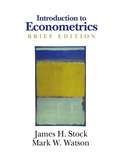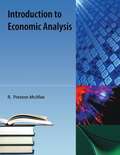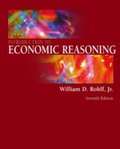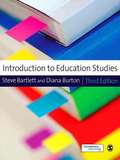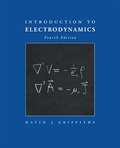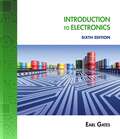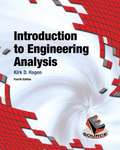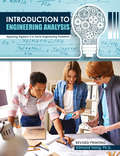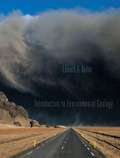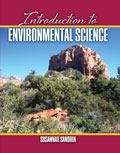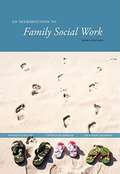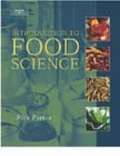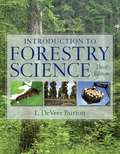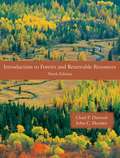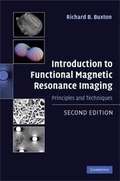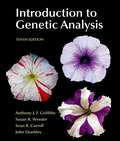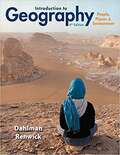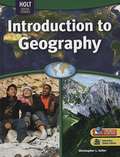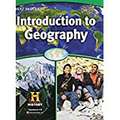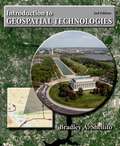- Table View
- List View
Introduction to Econometrics: Principles and Applications (3rd Edition)
by Harry H. Kelejian Wallace E. OatesIntroduction To Econometrics: Principles And Applications
Introduction To Econometrics (Brief Edition)
by James H. Stock Mark W. WatsonIn keeping with their successful introductory econometrics text, Stock and Watson motivate each methodological topic with a real-world policy application that uses data, so that readers apply the theory immediately. Introduction to Econometrics, Brief, is a streamlined version of their text, including the fundamental topics, an early review of statistics and probability, the core material of regression with cross-sectional data, and a capstone chapter on conducting empirical analysis. Introduction and Review: Economic Questions and Data; Review of Probability; Review of Statistics. Fundamentals of Regression Analysis: Linear Regression with One Regressor; Regression with a Single Regressor: Hypothesis Tests and Confidence Intervals in the Single-Regressor Model; Linear Regression with Multiple Regressors; Hypothesis Tests and Confidence Intervals in the Multiple Regressor Model; Nonlinear Regression Functions; Assessing Studies Based on Multiple Regression; Conducting a Regression Study Using Economic Data. MARKET: For all readers interested in econometrics.
Introduction to Economic Analysis
by R. Preston McafeeThis book presents introductory economics ("principles") material using standard mathematical tools, including calculus. It is designed for a relatively sophisticated undergraduate who has not taken a basic university course in economics. It also contains the standard intermediate microeconomics material and some material that ought to be standard but is not. The book can easily serve as an intermediate microeconomics text. The focus of this book is on the conceptual tools and not on fluff. Most microeconomics texts are mostly fluff and the fluff market is exceedingly over-served by $100+ texts. In contrast, this book reflects the approach actually adopted by the majority of economists for understanding economic activity. There are lots of models and equations and no pictures of economists.
Introduction to Economic Analysis
by R. Preston Mcafee Tracy R. LewisThis book presents standard intermediate microeconomics material and some material that, in the authors' view, ought to be standard but is not. Introductory economics material is integrated. Standard mathematical tools, including calculus, are used throughout. The book easily serves as an intermediate microeconomics text, and can be used for a relatively sophisticated undergraduate who has not taken a basic university course in economics. The focus of this book is on the conceptual tools and not on fluff. As such, it reflects the approach actually adopted by the majority of economists for understanding economic activity. There are lots of models and equations, and no pictures of economists ;-) Economic analysis is used in many situations. When British Petroleum sets the price for Alaskan crude oil, it uses an estimated demand model, both for gasoline consumers and also for the refineries to which BP sells. Economic analysis was used by experts in the antitrust suit brought by the U.S. Department of Justice both to understand Microsoft s incentive to foreclose (eliminate from the market) rival Netscape and consumer behavior in the face of alleged foreclosure. Stock market analysts use economic models to forecast the profits of companies to predict the price of their stocks. When the government forecasts the budget deficit or considers a change in environmental regulations, it uses economic models. This book presents the building blocks of the models in common use by an army of economists thousands of times per day. This book, plus econometrics, provides most of the economic analysis tools to take upper division economics courses of any type.
Introduction to Economic Analysis
by R. Preston Mcafee Tracy R. LewisThis book presents standard intermediate microeconomics material and some material that, in the authors' view, ought to be standard but is not. Introductory economics material is integrated. Standard mathematical tools, including calculus, are used throughout. The book easily serves as an intermediate microeconomics text, and can be used for a relatively sophisticated undergraduate who has not taken a basic university course in economics. The focus of this book is on the conceptual tools and not on fluff. As such, it reflects the approach actually adopted by the majority of economists for understanding economic activity. There are lots of models and equations, and no pictures of economists ;-) Economic analysis is used in many situations. When British Petroleum sets the price for Alaskan crude oil, it uses an estimated demand model, both for gasoline consumers and also for the refineries to which BP sells. Economic analysis was used by experts in the antitrust suit brought by the U.S. Department of Justice both to understand Microsoft s incentive to foreclose (eliminate from the market) rival Netscape and consumer behavior in the face of alleged foreclosure. Stock market analysts use economic models to forecast the profits of companies to predict the price of their stocks. When the government forecasts the budget deficit or considers a change in environmental regulations, it uses economic models. This book presents the building blocks of the models in common use by an army of economists thousands of times per day. This book, plus econometrics, provides most of the economic analysis tools to take upper division economics courses of any type.
Introduction To Economic Reasoning
by William D. RohlfWith a goal of encouraging students to become informed decision-makers, Introduction to Economic Reasoning, Seventh Edition, provides a non-technical, concise introduction to basic economic theories that is ideal for a one-semester course. The Seventh Edition relates coherent explanations of general theories and models with thought-provoking, current features that apply and enliven core concepts. The hands-on economic reasoning approach promotes the idea that students can use economic analysis in their everyday lives to help them succeed in their careers and understand today's global economic issues.
Introduction to Education Studies
by Dr Steve Bartlett Dr Diana M BurtonEducation Studies is a broad, multi-disciplinary and rapidly growing field. Introduction to Education Studies has proven itself to be the key text for students of the subject for over a decade, leading readers through the field's key strands, concepts and applications without assuming any prior knowledge. <P><P> Bartlett and Burton provide first-time students and those engaged in more advanced aspects of the subject with all the tools that they need to approach Education Studies and also encourage a critical, questioning approach which will put them in good stead for further study and professional practice.<P> The new edition includes:<P> * A new chapter on globalisation and international comparative education <P> * A new companion website featuring online journal articles relating to each chapter <P> * More guidance on how to critique research <P> * More 'Reader Reflection' boxes, encouraging students to reflect on their own practice throughout <P> * A new framework for analysing policy <P> * New sections within the curriculum and the history of schooling chapters reflecting the latest UK developments<P> * Complete update of education policy issues <P> Additional online resources at www.uk.sagepub.com/bartlett3e<P> Also available are free journal articles accompanying each chapter of the book, enabling discussion and further reading to deepen students knowlege of each chapter subject.<P> Steve Bartlett is Professor of Education Studies at the University of Wolverhampton.<P> Diana Burton is Professor of Education and Pro Vice Chancellor at Liverpool John Moores University.
Introduction to Electrodynamics (4th Edition)
by David J. GriffithsFor junior/senior-level electricity and magnetism courses. This book is known for its clear, concise, and accessible coverage of standard topics in a logical and pedagogically sound order. The highly polished Fourth Edition features a clear, accessible treatment of the fundamentals of electromagnetic theory, providing a sound platform for the exploration of related applications (ac circuits, antennas, transmission lines, plasmas, optics, etc. ). Its lean and focused approach employs numerous new examples and problems.
Introduction To Engineering Analysis
by Kirk HagenFor use in the first-year engineering course. This text is also suitable for individuals interested in adopting a problem-solving approach to engineering problems. <P><P> The goal of this text is to introduce a general problem-solving approach for the beginning engineering student. Thus, Introduction to Engineering Analysis focuses on how to solve (any) kind of engineering analytical problem in a logical and systematic way. The book helps to prepare the students for such analytically oriented courses as statics, strength of materials, electrical circuits, fluid mechanics, thermodynamics, etc.
Introduction to Engineering Analysis: Applying Algebra II to Solve Engineering Problems
by Edmund TsangIntroduction to Engineering Analysis: Applying Algebra II to Solve Engineering Problems
Introduction to Environmental Geology Fifth Edition
by Edward A. KellerThis text focuses on helping non-science majors develop an understanding of how geology and humanity interact. Ed Keller--the author who first defined the environmental geology curriculum--focuses on five fundamental concepts of environmental geology: Human Population Growth, Sustainability, Earth as a System, Hazardous Earth Processes, and Scientific Knowledge and Values. These concepts are introduced at the outset of the text, integrated throughout the text, and revisited at the end of each chapter. The Fifth Edition emphasizes currency, which is essential to this dynamic subject, and strengthens Keller's hallmark "Fundamental Concepts of Environmental Geology," unifying the text's diverse topics while applying the concepts to real-world examples.
Introduction to Environmental Science
by Susannah SandrinIntroduction To Environmental Science by Susannah Sandrin
An Introduction to European Law
by Robert SchützeThought-provoking and accessible in approach, this book offers a classic introduction to European law. Taking a clear structural framework, it guides the student through the subject's core elements from its creation and enforcement to the workings of the internal market. A flowing writing style combines with the use of illustrations and diagrams throughout the text to ensure the student understands even the most complex of concepts. This succinct and enlightening overview is required reading for all students of European law. Clearly sets out the key principles and central topics taught on EU law courses. Succinct overview which also indicates key debates and controversies in the field. Numerous illustrations reinforce key concepts to aid understanding.
An Introduction to Family Social Work
by Catheleen Jordan Heather Coleman Don CollinsThis text is intended for Methods/Practice with Families (Mezzo) courses in Social Work as a basic primer that introduces students to an overview of practice with families. It can also be used in Generalist Practice courses in which instructors want to emphasize work with families. Likewise, it is appropriate for paraprofessional, two-year human services programs.
Introduction to Food Science
by Rick Parker"Introduction to Food Science" provides an overview of the science of foods, from nutrition and digestion to processing and preservation. The material is based on a thorough, easy-to-follow outline that makes developing a lesson plan simple. Each chapter contains a list of learning objectives that help identify important concepts and key words that are essential to the understanding of the material. Tables, charts, graphs and illustrations are inserted throughout the text, providing quick and understandable access to information. The "student activities" section at the end of each chapter provide opportunities to directly apply material. The text also provides insight into career opportunities for those interested in working within food science industries.
Introduction to Forestry Science
by L. Devere BurtonPractical, easy to understand, and up-to-date, INTRODUCTION TO FORESTRY SCIENCE, Third Edition provides readers with a comprehensive overview of the principles and practices of forest management that are commonly practiced in the United States. Appropriate for anyone interested in forestry or natural resources, this book is filled with visual aids and tools as well as career profiles which give readers an overview of what it might be like to work in the forest industry and demonstrate how concepts are applied in the real world. In addition to covering the basics of the biological processes necessary for the creation of forests, topics such as the economic impact of forests on the U. S. economy, government historical events and policies, regional differences in forests and forest management, and laws and regulations that govern the use of forests are presented.
Introduction to Forests and Renewable Resources
by Chad P. Dawson John C. HendeeThe introductory course in natural resources is broader and more diverse than ever. Today's students need to know how to manage forest, wildlife, watershed, and range resources in a variety of environments and serving the needs of myriad stakeholders. To that end, Chad Dawson has built on the foundation established by him and the late John Hendee to bring Introduction to Forests and Renewable Resources thoroughly up to date. The Ninth Edition has been reorganized to better address content-for example, policy and the differences between managing federal, state, and private land--that applies to all resources. While forests continue to be emphasized, more coverage is provided to other resources and to achieving management goals for multiple resources when considering topics like fire and recreation.
Introduction to Formal Logic With Philosophical Applications
by Russell MarcusRigorous yet engaging and accessible, Introduction to Formal Logic with Philosophical Applications is composed of two parts. The first part (Chapters 1-5) provides a focused, "nuts-and-bolts" introduction to formal deductive logic that covers syntax, semantics, translation, and natural deduction for propositional and predicate logics. The second part (Chapters 6-7) presents stand-alone, student-friendly essays on logic and its application in philosophy and beyond, with writing prompts and suggestions for further readings.
Introduction to Functional Magnetic Resonance Imaging
by Richard B. BuxtonFunctional Magnetic Resonance Imaging (fMRI) has become a standard tool for mapping the working brain's activation patterns, both in health and in disease. It is an interdisciplinary field and crosses the borders of neuroscience, psychology, psychiatry, radiology, mathematics, physics and engineering. Developments in techniques, procedures and our understanding of this field are expanding rapidly. In this second edition of Introduction to Functional Magnetic Resonance Imaging, Richard Buxton - a leading authority on fMRI - provides an invaluable guide to how fMRI works, from introducing the basic ideas and principles to the underlying physics and physiology. He covers the relationship between fMRI and other imaging techniques and includes a guide to the statistical analysis of fMRI data. This book will be useful both to the experienced radiographer, and the clinician or researcher with no previous knowledge of the technology.
Introduction To Genetic Analysis
by Anthony J. F. Griffiths Susan R. Wessler Sean B. Carroll John DoebleySince its inception, Introduction to Genetic Analysis has been known for its prominent authorship--leading scientists in their field who are great educators. This market best-seller exposes students to the landmark experiments in genetics, teaching students how to analyze experimental data and how to draw their own conclusions based on scientific thinking while teaching students how to think like geneticists.
Introduction to Geography: People, Places and Environment
by Carl Dahlman William RenwickIntroduction to Geography: People, Places, & Environment, Sixth Edition introduces the major tools, techniques, and methodological approaches of the discipline through new applied visual features that engage students and reinforce real-world connections. <P><P> The authors emphasize the integration of various aspects of geographic processes and systems by discussing what happens in one set of geographic processes and how that affects others. For example, what happens in economic systems affects environmental conditions; what happens to climate affects political dynamics. The Sixth Edition has been tightly integrated with MasteringGeography™, Pearson’s online homework, tutorial, and assessment product designed to improve results by helping students quickly master concepts.
Introduction to Geospatial Technologies (Second Edition)
by Bradley A. ShellitoCombining both theoretical coverage and hands-on lab work, and accessible to majors and non-majors alike, Bradley Shellito's Introduction to Geospatial Technologies has become a new favorite for the digital Earth course. The new edition reflects the latest developments in the field, including how scientists are using GIS data with cloud technology. With lab activities that utilize both widely available freeware and ArcGIS, instructors can tailor the course to their students.

